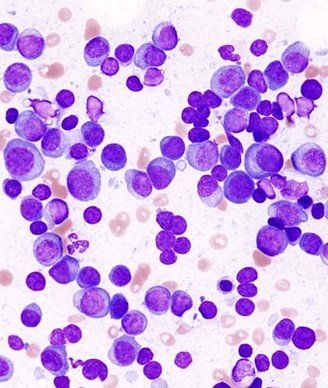Adding Elotuzumab Improved PFS in Relapsed Multiple Myeloma
The addition of elotuzumab to lenalidomide and dexamethasone improved progression-free survival and overall response rate in relapsed multiple myeloma patients.
Multiple myeloma, May-Grünwald-Giemsa stain. Image © 2006 KGH

The addition of the monoclonal antibody elotuzumab, which targets SLAMF7, to standard lenalidomide and dexamethasone resulted in an improved progression-free survival (PFS) and overall response rate compared with lenalidomide/dexamethasone alone in patients with relapsed multiple myeloma, according to the phase III results of the ELOQUENT-2 trial presented at a press cast ahead of the 2015 ASCO Annual Meeting.
“Patients who received elotuzumab had a longer duration of remission and higher overall response rate, and this occurred without significant increase in adverse events or toxicity,” said Sagar Lonial, MD, chief of the department of hematology and medical oncology at Emory University, who noted that this is the first monoclonal antibody to show benefit in patients with multiple myeloma.
Commenting on the results of the study, ASCO President-Elect Julie M. Vose, MD, MBA, FASCO, said: “Also, it is important to note that elotuzumab has a couple of different mechanisms of action not only against the myeloma cell itself, but also it boosts the ability of [natural killer] cells to the kill the cancer, so a two-pronged approach.”
The trial included 646 patients with relapsed or refractory multiple myeloma who had received one to three prior therapies. Patients were randomly assigned to lenalidomide/dexamethasone (n = 325) or lenalidomide/dexamethasone plus elotuzumab (n = 321). The primary endpoint of the trial was PFS and overall response rate.
At a median follow-up of 24 months, elotuzumab significantly improved PFS compared with lenalidomide/dexamethasone (HR = 0.70; 95% CI, 0.57–0.85; P = .0004). PFS at 1 year was 68% in the elotuzumab arm compared with 57% for the lenalidomide/dexamethasone-alone arm; at 2 years it was 41% vs 27%.
Lonial noted that the PFS Kaplan Meier curves are striking compared with many others because the two curves do not appear to come back together with longer follow-up.
“The idea of maintenance of benefit over time speaks to the power of an immune mediated–based approach when we treat cancer,” he said.
The overall response rate was 79% for patients assigned elotuzumab compared with 66% for standard therapy (P = .0002), an absolute difference of 13% at 24 months.
In May 2014, elotuzumab received breakthrough status from the FDA.
Newsletter
Stay up to date on recent advances in the multidisciplinary approach to cancer.